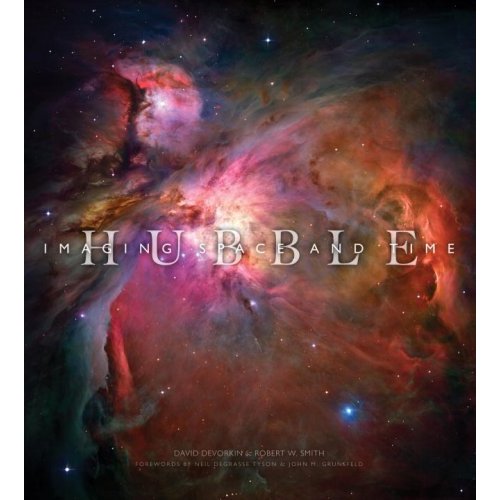[/caption]
The Hubble space telescope brought space’s beauty to the average person in North America. Via magazines, weblinks or video, the last few years this instrument dazzled us with a dizzying and splendid array of artistic and scientific sights. The book “Hubble: Imaging Space and Time” by David Devorkin and Robert W. Smith captures many of these treasures and the story of the Hubble telescope itself. Bright and vivacious, the telescope’s images within the book show that once again science is a captivating field.
The space shuttle Discovery carried the Hubble space telescope into its orbit in 1990. A great mirror in it collects light then focuses it upon a variety of collectors. The results get sent to Earth stations whereupon experts view and massaged it for maximum benefit. From the results, our knowledge progresses and our appreciation of the splendour of nature increases. And, with great foresight, the telescope designers created a maintainable system. So, many other shuttle missions have travelled to the telescope to upgrade instruments and repair components. One more mission, now waiting on the launch pad, will hopefully keep the telescope functional for many more years.
This book acknowledges the Hubble telescope’s storied past and its many contributions to science and art. Its large format is reminiscent of a coffee table book. The broad pages serve to fill the readers’ eyes with particularly photogenic images. As well, the many pages of text let the reader peer into some of the elements of the relevant science and technology. Of course, the book mentions the memorable repair mission to fix the mirror’s erroneous shape. It also mentions the different sensors, the means of allocating viewing time and the method of processing data. There’s even a significant section on the purposely driven artistic shots. With allusions to artists of the old American mid-West, the strive for dynamism of the universe, and the perception of a sublime frontier, the authors clearly aim to broaden the appeal of the pictures and the telescope’s capabilities.
Yet, the appeal of images from the Hubble space telescope is well established apart from this book. Hence, the focus of the authors is somewhat unclear. Hundreds of large and small images on the pages amply showcase the telescope’s products. But, though sectioned into defined chapters, the book has no central theme. The science of the telescope gets described, but the reader cannot gauge the scientific advances from the contents. The artistry of the images is richly brought forward, but there’s no formal discussion on the images’ general effect on the arts. As well, sometimes images appear twice, images appear well apart from and unreferenced to the apparently related text, or images are from other telescopes. These cause distractions. Fortunately, the images themselves are copious and incredibly rewarding, for without them, this book would be difficult at best.
So, perhaps the best location for this book to lie is upon a coffee table. Everyone who picks it up will be quickly enamoured. And they assuredly can’t help but think how trivial they are in relation to the size universe. Even thought the reader won’t know or be able to read of the value of the images, they should get immense pleasure just by being drawn into the realm of the book, far removed as it is from our everyday experience.
Satellites and telescopes have enabled us to view the Earth and the universe with an heretofore impossible vantage point and clarity. Millions of stars in a galaxy appear where only a dot once had been apparent. David Devorkin and Robert W. Smith’s book “Hubble: Imaging Space and Time” brings many of these wonders into the ready hands of viewers and closely, happily connects them with a broader existence.


“The Hubble space telescope brought space’s beauty to the average person in North America. ” – true …but what the majority of the planet … do they have something better?
I feel that Hubble images are used too much in astronomy books, what about the dozens of amateurs? If books ever use amateur pictures, they’re usually old ones from ages ago. I think overexposure to something lessens the visual impact. I guess this book is aimed at more general audience as amateur astronomers would already be overfamiliar with the Hubble pictures as they’re used in magazines and blogs.
“but what the majority of the planet … do they have something better?”
maybe some copyright legislation forbids us to look? I must find out, and stop breaking the law, if that’s the case..,..
😉